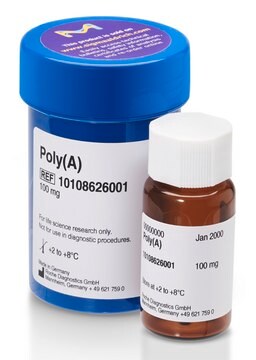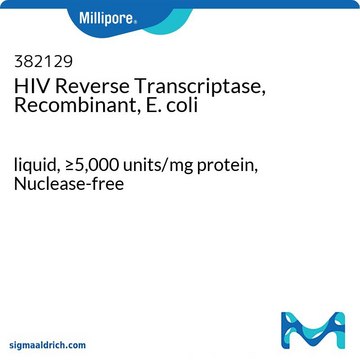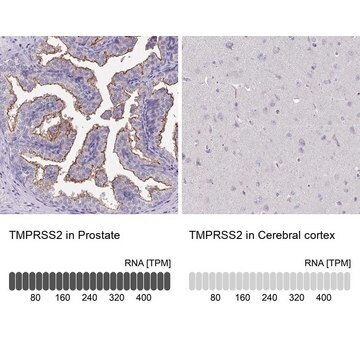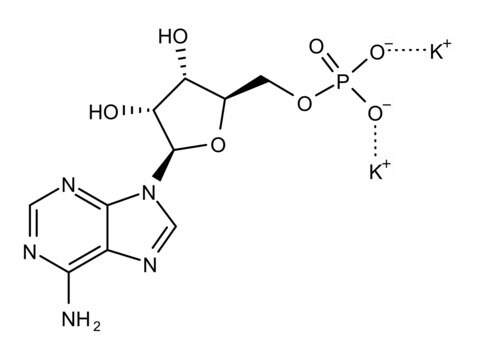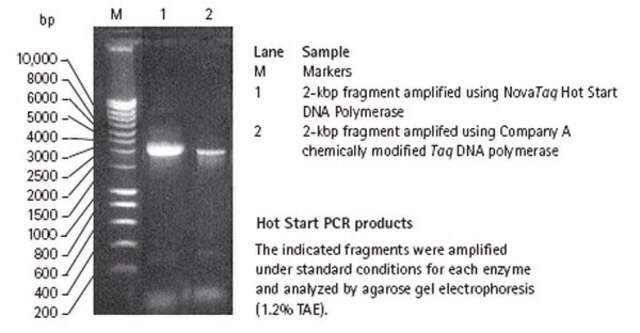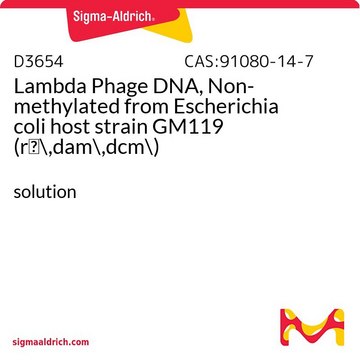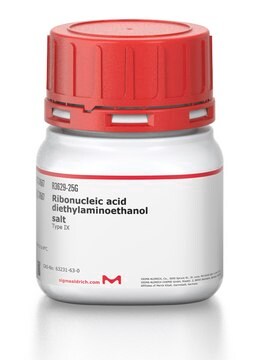10165948001
Roche
RNA, MS2
from bacteriophage MS2
Synonyme(s) :
RNA, ribonucleic acid
Se connecterpour consulter vos tarifs contractuels et ceux de votre entreprise/organisme
About This Item
Code UNSPSC :
41106311
Produits recommandés
Source biologique
bacteriophage MS2
Niveau de qualité
Forme
solution
Poids mol.
~1200 kDa
Conditionnement
pkg of 500 μL (10 A260 units)
Fabricant/nom de marque
Roche
Technique(s)
RNA extraction: suitable
Couleur
colorless
Solubilité
water: miscible
Température de stockage
−20°C (−15°C to −25°C)
Catégories apparentées
Description générale
RNA, from bacteriophage MS2 is composed of 3569 nucleotides. MS2 bacteriophage acts as a model system in studying molecular biology processes, such as viral RNA replication, process of translation and physiology of infected cells. MS2 RNA codes for three viral polypeptides namely, protein A, coat protein and RNA replicase complex. Protein A and coat protein make up the structure of MS2 virus.
Application
RNA, MS2 has been used:
- as a standard to assess RNA quantification methods
- in RNA extraction
- in single-tube, fluorescent PERT assay (STF-PERT) for accurate quantitation of different retrovirus types
- for studies which use natural RNA in a in vivo and in vitro protein-synthesizing system, initiation, elongation, and termination of polypeptide synthesis.
- for structural and functional studies.
- to stabilize RNA during cDNA synthesis
- to improve RNA yield during RNA extraction or isolation
Qualité
Typical analysis: Free of protein and host nucleic acids according to current Quality Control procedures.
Séquence
Chain Length 3,569 nucleotides
Notes préparatoires
Working solution: Storage buffer: 10 mM Tris-HCl, 1 mM EDTA, pH 7.0.
Autres remarques
For life science research only. Not for use in diagnostic procedures.
Code de la classe de stockage
12 - Non Combustible Liquids
Classe de danger pour l'eau (WGK)
nwg
Point d'éclair (°F)
No data available
Point d'éclair (°C)
No data available
Faites votre choix parmi les versions les plus récentes :
Déjà en possession de ce produit ?
Retrouvez la documentation relative aux produits que vous avez récemment achetés dans la Bibliothèque de documents.
Les clients ont également consulté
Rom S Leidner et al.
PloS one, 8(3), e57841-e57841 (2013-03-09)
Genome-wide platforms for high-throughput profiling of circulating miRNA (oligoarray or miR-Seq) offer enormous promise for agnostic discovery of circulating miRNA biomarkers as a pathway for development in breast cancer detection. By harmonizing data from 15 previous reports, we found widespread
Thomas C Roberts et al.
Biological procedures online, 16(1), 5-5 (2014-03-19)
MicroRNAs (miRNAs) are short RNA molecules which regulate gene expression in eukaryotic cells, and are abundant and stable in biofluids such as blood serum and plasma. As such, there has been heightened interest in the utility of extracellular miRNAs as
Roman Aranda et al.
Analytical biochemistry, 387(1), 122-127 (2009-05-21)
Quantification of RNA is essential for various molecular biology studies. In this work, three quantification methods were evaluated: ultraviolet (UV) absorbance, microcapillary electrophoresis (MCE), and fluorescence-based quantification. Viral, bacterial, and eukaryotic RNA were measured in the 500 to 0.05-ng microl(-1)
Michael Eikmans et al.
International journal of molecular sciences, 21(11) (2020-06-12)
About 10-15% of couples who want to conceive suffer from subfertility, while in 30% of these cases, a male factor plays a role. Levels of particular microRNAs in seminal plasma, including those involved in spermatogenesis, may serve as an indicative
Shalini Das Gupta et al.
Scientific reports, 10(1), 9012-9012 (2020-06-04)
Quantification of plasma microRNAs (miRNAs) as non-invasive disease biomarkers is subject to multiple technical variabilities. This study aimed to develop an optimized protocol for miRNA quantification from rodent plasma. We hypothesized that a fixed small RNA concentration input for reverse
Notre équipe de scientifiques dispose d'une expérience dans tous les secteurs de la recherche, notamment en sciences de la vie, science des matériaux, synthèse chimique, chromatographie, analyse et dans de nombreux autres domaines..
Contacter notre Service technique